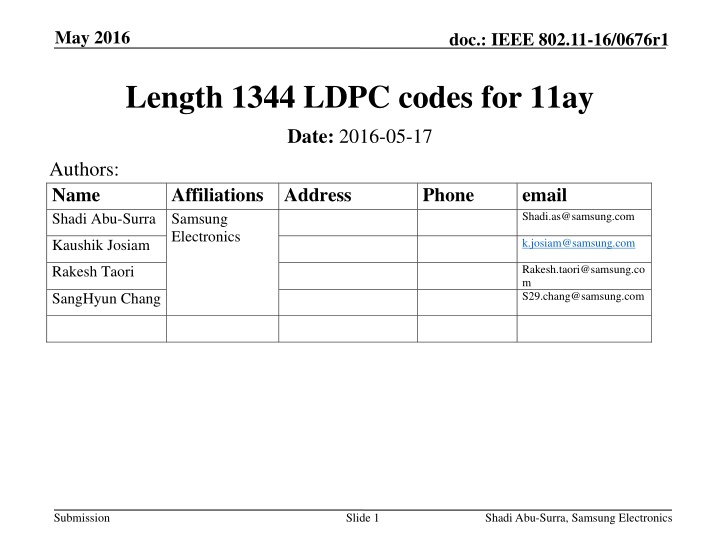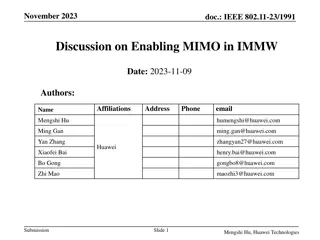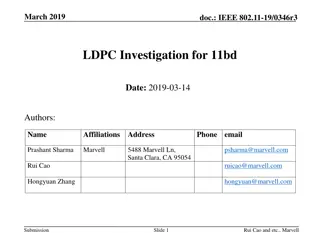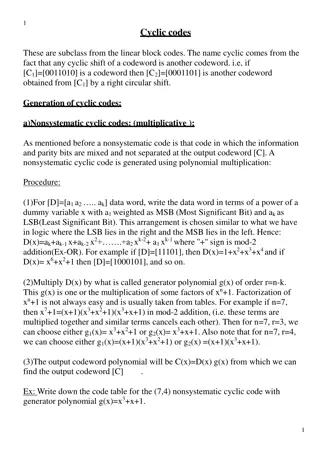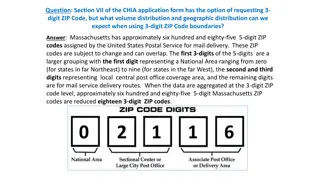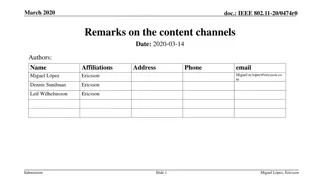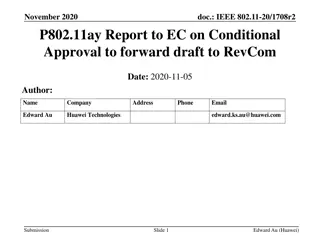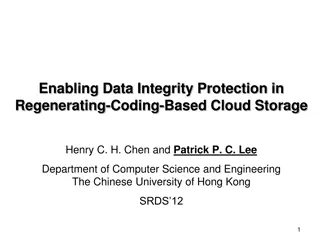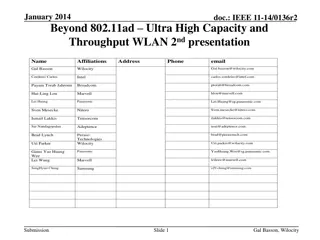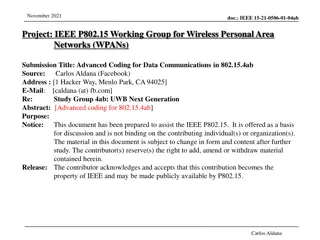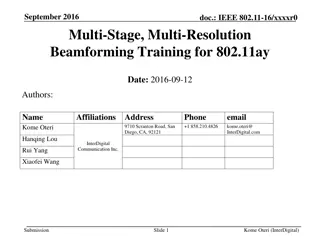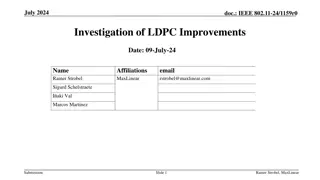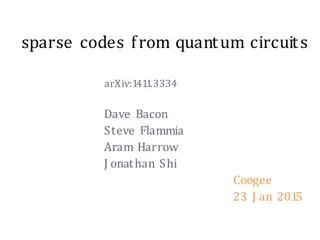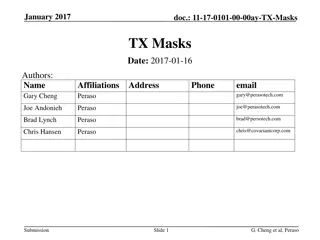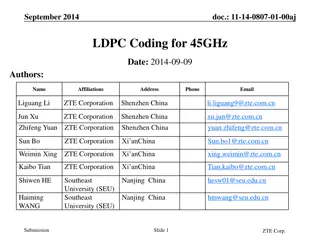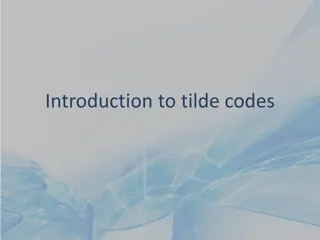Proposal for Longer LDPC Codes Based on 11ad for 11ay
We propose a Length-1344 LDPC block as an enhancement over the 11ad codes for use in 11ay, aiming for about 1 dB of coding gain. This longer LDPC code design offers potential performance improvements for channel bonding and MIMO features of the 11ay specification, supporting the goal of achieving over 20Gbps throughput. The structural advantages of the proposed longer block LDPC codes include two-step lifting matrices with in-place properties, reusing the 11ad decoding machine for scalability, improved efficiency, and granularity.
Download Presentation

Please find below an Image/Link to download the presentation.
The content on the website is provided AS IS for your information and personal use only. It may not be sold, licensed, or shared on other websites without obtaining consent from the author.If you encounter any issues during the download, it is possible that the publisher has removed the file from their server.
You are allowed to download the files provided on this website for personal or commercial use, subject to the condition that they are used lawfully. All files are the property of their respective owners.
The content on the website is provided AS IS for your information and personal use only. It may not be sold, licensed, or shared on other websites without obtaining consent from the author.
E N D
Presentation Transcript
May 2016 doc.: IEEE 802.11-16/0676r1 Length 1344 LDPC codes for 11ay Date: 2016-05-17 Authors: Name Shadi Abu-Surra Samsung Affiliations Address Phone email Shadi.as@samsung.com Electronics k.josiam@samsung.com Kaushik Josiam Rakesh.taori@samsung.co m S29.chang@samsung.com Rakesh Taori SangHyun Chang Submission Slide 1 Shadi Abu-Surra, Samsung Electronics
May 2016 doc.: IEEE 802.11-16/0676r1 Abstract We propose a Length-1344 LDPC block based on 11ad codes for use in 11ay About 1 dB of coding gain compared to length-672 code set in 11ad. Submission Slide 2 Shadi Abu-Surra, Samsung Electronics
May 2016 doc.: IEEE 802.11-16/0676r1 Introduction Channel bonding and MIMO are core features of 11ay specification. To realize the 20Gbps+ throughput goal specified in the PAR In this presentation, we propose enhancements to the 11ad channel coding scheme that can provide significant PER performance improvement when large packets are to be transmitted We propose the use of a longer length LDPC code for 11ay 11ad had defined 672 length LDPC codes. We investigate a LDPC code design that is twice that length i.e., length 1344 LDPC code. ~1dB gain over 11ad LDPC codes Submission Slide 3 Shadi Abu-Surra, Samsung Electronics
May 2016 doc.: IEEE 802.11-16/0676r1 Length 1344 LDPC codes We propose new longer block LDPC block based on 11ad codes Two-step lifting matrices with in-place property. 11ad codes are in-place. Designed in-place 2nd lifting The larger codes are also in-place. Architecture advantages for the two-step lifting design. Allow re-use of the 11ad decoding machine wrapped with MUX and Memory. Facilitate scalable architectures (easy to support 2x, 3x, ) Provide better granularity higher efficiency. Submission Slide 4 Shadi Abu-Surra, Samsung Electronics
May 2016 doc.: IEEE 802.11-16/0676r1 Proposed rate-13/16 -1 29 29 -1 4 -1 -1 4 1 0 1 0 0 0 1 0 1 1 0 1 1 0 0 1 1 1 0 0 0 0 0 1 1 0 0 1 0 0 0 0 1 1 1 0 1 1 1 0 1 0 -1 0 0 -1 -1 0 2nd lifting The lifting matrix above are applied on this 11ad base matrix. 29 37 25 30 31 22 0 8 33 11 31 22 21 3 17 6 14 4 27 32 4 28 9 2 20 12 14 27 29 18 24 10 13 23 0 13 -1 13 22 -1 -1 24 11ad code 18 4 23 34 20 15 -1 29 37 -1 -1 25 29 -1 -1 37 25 -1 30 -1 31 -1 22 -1 -1 30 -1 31 -1 22 -1 0 18 -1 -1 4 0 -1 -1 18 4 -1 -1 8 23 -1 -1 34 8 -1 -1 23 34 -1 -1 33 11 -1 31 -1 33 -1 -1 11 -1 31 -1 22 -1 21 -1 3 22 -1 21 -1 3 -1 17 -1 6 -1 14 -1 -1 17 -1 6 -1 14 4 -1 20 -1 -1 15 -1 4 -1 20 15 -1 -1 27 32 -1 4 -1 27 -1 -1 32 -1 4 -1 28 9 -1 2 -1 28 -1 -1 9 -1 2 20 -1 12 -1 -1 14 -1 20 -1 12 14 -1 -1 27 -1 29 18 -1 27 -1 29 -1 -1 18 -1 24 -1 10 -1 13 24 -1 10 -1 13 -1 23 -1 -1 0 13 -1 -1 23 0 -1 -1 13 -1 -1 13 -1 22 -1 -1 -1 -1 13 -1 22 -1 -1 -1 -1 24 -1 -1 -1 -1 -1 -1 24 length-1344 code The lifting factor, Z, is 42 in both length-672 (11ad) and length-1344 proposed codes. Both codes share the same set of shifters. Simplify designing shared decoder for 11ad + length-1344 codes (See, Appendix II) Note: If the 2ndlifting is all 0 s (or, all 1 s), then the length-1344 codes is an interleaving of two length-672 codes (No coding gain). It is the optimized mix of 0 s and 1 s in the 2nd lifting that gives the coding gain. Also, it is clear that a decoding machine with programmable 2nd lifting allow decoding one length-1344 or two length-672 codes. Submission Shadi Abu-Surra, Samsung Electronics 5
May 2016 doc.: IEEE 802.11-16/0676r1 Proposed rate-3/4 code N=1344 Zp = 2 0 0 1 1 1 0 0 1 0 0 1 1 0 -1 -1 -1 1 0 1 0 0 0 1 0 1 1 0 1 1 0 0 1 1 1 0 0 0 0 0 1 1 0 0 1 0 -1 0 0 1 1 1 0 1 -1 1 0 1 0 -1 0 0 -1 -1 0 The lifting matrix above are applied on this 11ad base matrix. 35 29 37 25 19 30 31 22 41 0 18 4 22 8 23 34 40 33 11 31 41 22 21 3 39 17 6 14 6 4 28 27 32 4 18 28 9 -1 17 20 12 14 3 28 24 -1 13 -1 23 0 13 -1 -1 13 22 -1 -1 -1 24 27 29 18 20 15 Submission Shadi Abu-Surra, Samsung Electronics 6
May 2016 doc.: IEEE 802.11-16/0676r1 Proposed rate-5/8 code N=1344 Zp = 2 0 0 0 1 -1 -1 0 1 -1 -1 0 0 1 -1 1 1 -1 -1 1 1 -1 -1 0 1 0 -1 1 -1 -1 0 0 1 -1 1 1 -1 1 0 0 -1 -1 0 1 0 -1 0 0 -1 -1 1 0 -1 -1 0 1 1 -1 1 0 -1 0 0 -1 -1 0 -1 -1 0 1 1 -1 -1 -1 -1 0 1 -1 -1 -1 -1 -1 0 1 -1 -1 -1 -1 -1 0 0 -1 -1 -1 -1 -1 0 The lifting matrix above are applied on this 11ad base matrix. 20 30 35 29 -1 -1 36 27 -1 -1 31 22 34 -1 41 0 -1 -1 31 18 -1 -1 23 34 20 -1 40 -1 -1 31 7 12 -1 22 21 -1 41 20 39 -1 -1 14 34 14 -1 4 20 -1 -1 2 28 -1 -1 4 10 25 -1 28 9 -1 41 15 -1 -1 12 -1 -1 6 3 27 -1 -1 -1 -1 28 24 -1 -1 -1 -1 -1 23 0 -1 -1 -1 -1 -1 13 22 -1 -1 -1 -1 -1 24 Submission Shadi Abu-Surra, Samsung Electronics 7
May 2016 doc.: IEEE 802.11-16/0676r1 Proposed rate-1/2 code 0 0 -1 -1 0 1 -1 -1 -1 -1 0 1 -1 -1 0 0 1 0 -1 -1 1 1 -1 -1 -1 -1 1 1 -1 -1 0 1 0 1 -1 -1 1 -1 -1 0 -1 -1 0 1 -1 1 1 -1 1 -1 -1 0 0 -1 -1 0 -1 1 1 -1 -1 0 0 -1 0 0 -1 -1 0 -1 -1 0 -1 0 1 -1 -1 1 -1 -1 -1 -1 0 0 -1 -1 0 -1 -1 -1 -1 0 1 1 -1 -1 -1 -1 -1 -1 0 -1 -1 1 -1 -1 -1 -1 -1 0 1 -1 -1 -1 -1 -1 -1 -1 0 0 -1 -1 -1 -1 -1 -1 -1 0 N=1344 Zp = 2 40 34 -1 -1 35 29 -1 -1 -1 -1 36 27 -1 -1 31 22 38 35 -1 -1 41 0 -1 -1 -1 -1 31 18 -1 -1 23 34 13 27 -1 -1 40 -1 -1 31 -1 -1 7 12 -1 22 21 -1 5 -1 -1 20 39 -1 -1 14 -1 30 34 -1 -1 4 20 -1 18 2 -1 -1 28 -1 -1 4 -1 1 10 -1 -1 28 -1 -1 -1 -1 41 15 -1 -1 12 -1 -1 -1 -1 6 3 27 -1 -1 -1 -1 -1 -1 28 -1 -1 13 -1 -1 -1 -1 -1 23 0 -1 -1 -1 -1 -1 -1 -1 13 22 -1 -1 -1 -1 -1 -1 -1 24 The lifting matrix above are applied on this 11ad base matrix. Submission Shadi Abu-Surra, Samsung Electronics 8
May 2016 doc.: IEEE 802.11-16/0676r1 Proposed rate-7/8 code Rate-7/8 length-1248 is derived by puncturing the first 96 parity bits of the rate-13/16 length-1344 code. As is currently done in 11ad (adopted recently in Revmc) Submission Slide 9 Shadi Abu-Surra, Samsung Electronics
May 2016 doc.: IEEE 802.11-16/0676r1 1344 lifting matrices are in-place In-place property lower the decoding complexity for fully-parallel (flooding) architectures. Both 11ad codes and the proposed 2nd lifting are in-place 1344 codes are in-place. 0 0 -1 -1 0 1 -1 -1 -1 -1 0 1 -1 -1 0 0 1 0 -1 -1 1 1 -1 -1 -1 -1 1 1 -1 -1 0 1 0 1 -1 -1 1 -1 -1 0 -1 -1 0 1 -1 1 1 -1 1 -1 -1 0 0 -1 -1 0 -1 1 1 -1 -1 0 0 -1 0 0 -1 -1 0 -1 -1 0 -1 0 1 -1 -1 1 -1 -1 -1 -1 0 0 -1 -1 0 -1 -1 -1 -1 0 1 1 -1 -1 -1 -1 -1 -1 0 -1 -1 1 -1 -1 -1 -1 -1 0 1 -1 -1 -1 -1 -1 -1 -1 0 0 -1 -1 -1 -1 -1 -1 -1 0 Rate 1/2 0 0 0 1 -1 -1 0 1 -1 -1 0 0 1 -1 1 1 -1 -1 1 1 -1 -1 0 1 0 -1 1 -1 -1 0 0 1 -1 1 1 -1 1 0 0 -1 -1 0 1 0 -1 0 0 -1 -1 1 0 -1 -1 0 1 1 -1 1 0 -1 0 0 -1 -1 0 -1 -1 0 1 1 -1 -1 -1 -1 0 1 -1 -1 -1 -1 -1 0 1 -1 -1 -1 -1 -1 0 0 -1 -1 -1 -1 -1 0 Rate 5/8 0 0 1 1 1 0 0 1 0 0 1 1 0 -1 -1 -1 Rate 3/4 1 0 1 0 0 0 1 0 1 1 0 1 1 0 0 1 1 1 0 0 0 0 0 1 1 0 0 1 0 -1 0 0 1 1 1 0 1 -1 1 0 1 0 -1 0 0 -1 -1 0 1 0 1 0 0 0 1 0 1 1 0 1 1 0 0 1 1 1 0 0 0 0 0 1 1 0 0 1 0 0 0 0 1 1 1 0 1 1 1 0 1 0 -1 0 0 -1 -1 0 Rate 13/16 Non -1 values in the same column and in rows of the same color are identical. Submission Shadi Abu-Surra, Samsung Electronics 10
May 2016 doc.: IEEE 802.11-16/0676r1 Simulation setup Simulation environment: Packet length 4096 Bytes. OFDM tone mappings for QPSK, 16-QAM, and 64-QAM are shown in Appendix I. Conference Room model used in 11ad [2]. Fs = 5.28 GHz Directional Tx Directional Rx NLOS No HW impairments. Ideal channel estimation. MMSE equalization. [2] 2015-TECH-Samsung-0002-00-Channel Coding Framework for 802.11ay - Channel Bonding and MIMO in OFDM PHY Submission Shadi Abu-Surra, Samsung Electronics 11
May 2016 doc.: IEEE 802.11-16/0676r1 In-place two-step lifting performance: QPSK Coding gains @ 1% PER : 0.75, 0.65, 0.7 dB Submission Shadi Abu-Surra, Samsung Electronics 12
May 2016 doc.: IEEE 802.11-16/0676r1 In-place two-step lifting performance: QPSK ~ 0.8 dB gain Submission Shadi Abu-Surra, Samsung Electronics 13
May 2016 doc.: IEEE 802.11-16/0676r1 In-place two-step lifting performance: 16-QAM Coding gains @ 1% PER : 1.0, 1.6, 1.0, 0.7, 1.0 dB Note: Rate-7/8 is created by puncturing the rate-13/16 code Submission Shadi Abu-Surra, Samsung Electronics 14
May 2016 doc.: IEEE 802.11-16/0676r1 In-place two-step lifting performance: 16-QAM ~ 0.8 dB gain Submission Shadi Abu-Surra, Samsung Electronics 15
May 2016 doc.: IEEE 802.11-16/0676r1 In-place two-step lifting performance: 64-QAM Coding gains @ 1% PER: 1.4, 1.15, 0.5, 1.0 dB Submission Shadi Abu-Surra, Samsung Electronics 16
May 2016 doc.: IEEE 802.11-16/0676r1 In-place two-step lifting performance: 64-QAM ~ 0.8 dB gain Submission Shadi Abu-Surra, Samsung Electronics 17
May 2016 doc.: IEEE 802.11-16/0676r1 Theoretical improvement of the proposed L1344 over the L672 in 11ad minimum distance Rate 1/2 5/8 3/4 13/16 Proposed L1344 Two-step code set has larger minimum distances than the L672 (11ad) codes. L1344 19 13 12 8 L672 (11ad) 17 12 9 6 The minimum cycle-size of any code in both sets is 6. Two-step lifting codes have significantly lower number of 6-cycles than that in the L672 (11ad) codes. Number of 6-cycles Rate 1/2 5/8 3/4 13/16 L1344 84 168 5796 1680 L672 (11ad) 504 714 7476 2646 Submission Slide 18 Shadi Abu-Surra, Samsung Electronics
May 2016 doc.: IEEE 802.11-16/0676r1 Summary Two step lifting matrix construction for new longer block length LDPC codes with 11ad codes in-place Compared to 11ad, longer codes have ~ 1 dB gain and another ~1dB can be extracted from interleaving Two step lifting has better minimum-distance and small-cycle properties than extended lifting. Architecture advantages for the two-step lifting design. Allow re-use of the 11ad decoding machine wrapped with MUX and Memory. Facilitate scalable architectures (easy to support 2x, 3x, ) Provide better granularity higher efficiency. Submission Slide 19 Shadi Abu-Surra, Samsung Electronics
May 2016 doc.: IEEE 802.11-16/0676r1 Straw Poll Do you agree to use the code matrices listed in slides 5- 8 for length 1344 LDPC code in IEEE 802.11ay? 27Y/0N/8A Submission Slide 20 Shadi Abu-Surra, Samsung Electronics
May 2016 doc.: IEEE 802.11-16/0676r1 References [11ad] IEEE 802.11ad-2012 standard. [2] 11-09-0334-08-00ad-channel-models-for-60-ghz-wlan- systems. Submission Slide 21 Shadi Abu-Surra, Samsung Electronics
May 2016 doc.: IEEE 802.11-16/0676r1 Appendix I Submission Slide 22 Shadi Abu-Surra, Samsung Electronics
May 2016 doc.: IEEE 802.11-16/0676r1 OFDM parameters for 2x channel bonding (only for simulation purpose) Parameter Notation Value (11ad) Value (2x) FFT Size NFFT NSD NSP Fs F TGI 512 1024 Number of data subcarriers 336 672 Number of pilot subcarriers 16 32 OFDM sampling frequency 2640 MHz 5280 MHz Subcarrier frequency spacing 5.16 MHz 5.16 MHz Guard Interval/Cyclic Prefix 128/Fs= ~48ns 256/Fs= ~48ns Ref [11ad] -32 32 209 -386 -209 386 Submission 23 Shadi Abu-Surra, Samsung Electronics
May 2016 doc.: IEEE 802.11-16/0676r1 Simulation setup OFDM Tone Mapping: QPSK Submission Slide 24 Shadi Abu-Surra, Samsung Electronics
May 2016 doc.: IEEE 802.11-16/0676r1 Simulation setup OFDM Tone Mapping: 16-QAM Submission Slide 25 Shadi Abu-Surra, Samsung Electronics
May 2016 doc.: IEEE 802.11-16/0676r1 Simulation setup OFDM Tone Mapping: 64-QAM Submission Slide 26 Shadi Abu-Surra, Samsung Electronics
May 2016 doc.: IEEE 802.11-16/0676r1 Appendix II Submission Slide 27 Shadi Abu-Surra, Samsung Electronics
May 2016 doc.: IEEE 802.11-16/0676r1 Layered Decoder: Architectures (1x Throughput*) - Re-use of the 11ad decoding machine wrapped with MUX and Memory - Only 4% increase in area due to the extra MUXs (excluding the memory) 11ad LDPC decoder 11ad + 2-step 1344 shared LDPC decoder 11ad machine 11ad machine Check Node 41 (degree 16) Check Node 41 (degree 16) Check Node 0 (degree 16) Check Node 0 (degree 16) 42 Shifter 42 Shifter 16x 42 Shifter 42 Shifter 16x Gamma Proc. Gamma Proc. Gamma Proc. Gamma Proc. 16x 16x MUX MUX LLR Mem. LLR Mem. 16x 16x LLR Mem. LLR Mem. LLR Mem. LLR Mem. 42 values 42 values * 1x throughput relative to 11ad machine assuming same number of iterations. 42 values 42 values 42 values 42 values Submission 28 Shadi Abu-Surra, Samsung Electronics
May 2016 doc.: IEEE 802.11-16/0676r1 Layer Decoder: Architectures (2x Throughput*) 11ad + 2-step 1344 shared LDPC decoder 11ad machine Check Node 41 (degree 16) Scalable Architecture in throughput increase, which reuse the 11ad machine 11ad machine Check Node 0 (degree 16) Check Node 41 (degree 16) Check Node 0 (degree 16) 42 Shifter 42 Shifter 16x 42 Shifter 42 Shifter 16x Gamma Proc. Gamma Proc. 16x Gamma Proc. Gamma Proc. 16x MUX MUX 16x * 2x throughput relative to 11ad machine assuming same number of iterations. LLR Mem. LLR Mem. LLR Mem. LLR Mem. 42 values 42 values 42 values 42 values Submission 29 Shadi Abu-Surra, Samsung Electronics
May 2016 doc.: IEEE 802.11-16/0676r1 Appendix III Submission Slide 30 Shadi Abu-Surra, Samsung Electronics
May 2016 doc.: IEEE 802.11-16/0676r1 Theoretical comparison: Proposed L1344, 11ad codes with Z=84 (instead of Z =42), and L672 in 11ad minimum distance Rate 1/2 5/8 3/4 L1344 19 13 12 11ad w/ Z =84 18 13 9 L672 (11ad) 17 12 9 13/16 8 6 6 Number of 6-cycles Rate 1/2 5/8 3/4 13/16 L1344 84 168 5796 1680 11ad w/ Z =84 420 756 9492 3948 L672 (11ad) 504 714 7476 2646 Proposed L1344 Two-step code set has larger minimum distances than the 11ad w/ Z-84 codes. The minimum cycle-size of any code in both sets is 6. Proposed two-step lifting codes have significantly lower number of 6-cycles than that in the 11ad w/ Z-84 codes. Submission Slide 31 Shadi Abu-Surra, Samsung Electronics
May 2016 doc.: IEEE 802.11-16/0676r1 Performance comparison: Proposed L1344 vs 11ad codes with Z=84 (instead of Z =42) Proposed codes provides about [0.1, 0.2, 0.2, 0.6] dB gain over AWGN channel, and up to 0.9 dB gain over Conference Room channel. Submission Slide 32 Shadi Abu-Surra, Samsung Electronics
